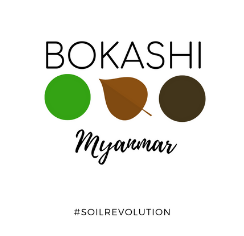Note that your bokashi will still look much the same when it has finished fermenting. It will only turn to soil once it is mixed with soil in the ground or in a container — you won’t get soil in your bucket.
The basic principle is to mix the fermented bokashi with some kind of soil and wait for it to change from food waste to fertile soil. This will take from two to four weeks in “real” soil but the speed depends on how much microbial life there is in the original soil. Try adding some brown leaves when you dig down your bokashi – they add valuable carbon and structure to the soil.

There are a number of different methods, but all involve mixing bokashi with soil in some type of hole or container.
Read more here:
Digging bokashi into a garden bed
Dig a trench in the ground and empty the contents of the fermented bokashi barrel. Mix with soil/sand and cover with a 10-30 cm layer of soil/sand.
Using bokashi in a raised garden bed
Create a raised bed using planks, logs, bricks or other materials on top of the ground. If there is grass or weeds on the location, cover them with of a thick layer newspaper or cardboard (not plastic) before making the bed. No need to dig. Empty the contents of the bokashi barrel and cover with soil/sand.
Making potting mix in a planting container
Use any form of planting container to make soil in. Layer soil/bokashi/soil in this. 50:50 bokashi:soil is ideal. You will need a drainage hole. Ensure the mixture is reasonable well mixed and add a layer of soil/sand to the top of the container. Water only as needed to keep the contents moist but not wet.
In all cases, it makes sense to cover the soil factory loosely for the first couple of weeks to protect from heavy rain and curious animals. Some animals love the smell of bokashi and will dig! The soil needs to be able to breathe, so should not be covered tightly.
Check after a couple of weeks and see how the process is going. When you can no longer see the food waste, it means it has been absorbed into the soil and the soil can be used, either for planting or as a fertilizer.
If you wish, you can add another layer of bokashi and soil on top of the first layer.
You can plant at any time, but make sure no plant roots will touch the bokashi in the first two weeks after it is buried down. During this period, the bokashi is quite acidic and will burn the roots. If you are sowing from seeds into a top layer of soil, you can probably sow on the same day you bury your bokashi as the seeds will take a couple of weeks to grow deep roots.
Making a bokashi compost stack
This is the ideal solution if you have a lot of dry leaves in your garden. Here we explain how to build your own compost stack and make the best possible use of all your green and brown garden waste.
Read more: How to make a bokashi compost stack
Anything else that’s good to know?
- Bokashi is an anaerobic process, which means it works without oxygen. Keep the barrel closed at all times, and try to fill it just once or twice per day.
- Do not add plastic or any other type of inorganic waste. Only things that have once been living should be added to a bokashi barrel.
- Food scraps are often wet. If you can, let them dry up a bit before adding them to the bokashi container (wet tea leaves and coffee grounds especially). Avoid adding liquids such as soups or milk to the container; you can strain them if you like and add the solids).
- The contents of your bokashi barrel shouldn’t smell (other than a slightly sour fermentation smell). If you think it smells stronger than it should, check for condensation on the underside of the lid. If you see moisture droplets there, it’s too wet in your container and this is causing the smell. Just add something absorbent (like an egg carton, toilet roll, rice hus, charcoal) to take up the moisture. Maybe some extra bran. The smell should disappear quite quickly.
- You can add any type of food scraps to your bokashi container. Meat, fish, cheese, cooked foods, vegetables, tea, coffee, dead flowers. If you have a lot of the same type of food, try to layer it with other scraps. If you have food scraps that are high in protein (meat, fish), use a little extra bokashi bran to help them get started.
- If you can, chop your food scraps into smallish pieces. This will help you fit more into the container and speed up the fermentation process making it easier to make soil later.
- Any kind of airtight container or bucket can be used for bokashi. Any form of absorbent material can be used in the bottom as long as it is natural (shredded paper, crushed charcoal, rice, coconut fiber).
- The container can be stored indoors or outdoors, wherever is convenient.
- It doesn’t matter how long it takes you to fill the barrel or how quickly you fill it, the process will work anyway. If you are going away, just leave it as is and continue filling it when you come back, no problem.
We’ve made a list of frequently asked questions here!
